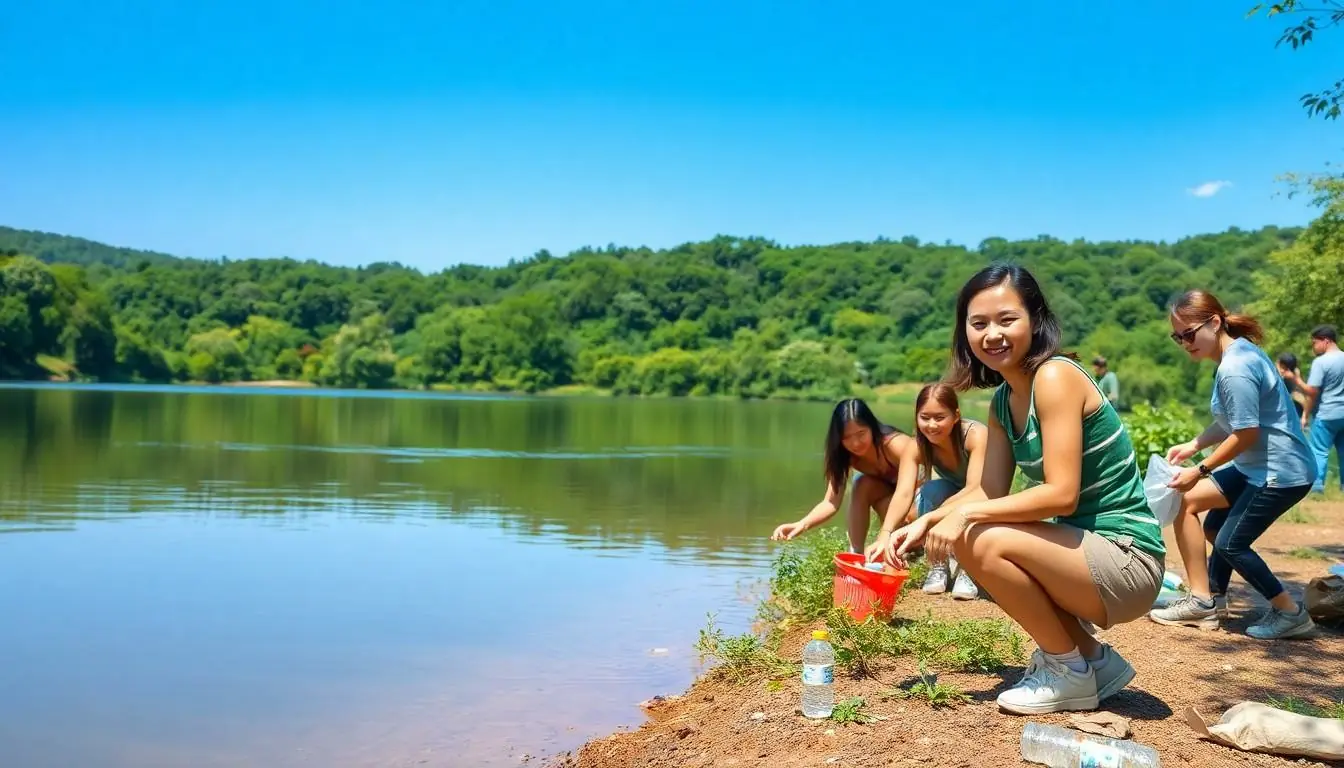Water pollution is like that uninvited guest who crashes your party and spills drinks everywhere. It sneaks in silently, often leaving a trail of destruction that can affect everything from marine life to human health. Understanding how water gets contaminated is crucial for tackling this pressing issue.
Two major mechanisms contribute to this watery chaos: point source pollution and non-point source pollution. Think of point source pollution as the clearly labeled bottle of soda spilling over, while non-point source pollution is more like that mysterious splash from an unknown source. By diving into these mechanisms, we can better grasp the complexities of water pollution and take steps to protect our precious resources.
Table of Contents
ToggleOverview Of Water Pollution
Water pollution represents a serious concern for ecosystems and human health. Recognizing the two primary mechanisms assists in understanding the complexity of contamination. Point source pollution involves direct discharges into water bodies. Examples include wastewater treatment plants and industrial outfalls, where pollutants enter through a specific location.
Non-point source pollution differs significantly. This mechanism arises from multiple diffuse sources and lacks a clear origin. Stormwater runoff often carries fertilizers, pesticides, and other contaminants from urban and agricultural areas into rivers and lakes.
Identifying these mechanisms is crucial for implementing effective management strategies. Point source pollution can be monitored and regulated effectively due to its identifiable nature. Conversely, tackling non-point source pollution requires coordinated efforts across various sectors.
Both mechanisms contribute to the decline of water quality, making remediation efforts essential. Protective measures and public awareness programs can reduce pollution levels significantly. Comprehensive measures focus on both prevention and control strategies to safeguard water resources.
Mechanisms Of Water Pollution

Understanding how water pollution occurs involves recognizing its two primary mechanisms: point source pollution and non-point source pollution. Both play significant roles in contaminating water bodies and degrading water quality.
Point Source Pollution
Point source pollution originates from specific, identifiable sources. Discharges from wastewater treatment plants and industrial facilities exemplify this type of pollution. Regulations can effectively manage these sources since they offer clear targets for monitoring and controlling contaminants. Industries often release pollutants directly into rivers, lakes, or oceans, leading to localized contamination. Therefore, heightened oversight ensures compliance with environmental standards, promoting cleaner water resources.
Non-Point Source Pollution
Non-point source pollution arises from various diffuse sources, making it challenging to pinpoint exact origins. Stormwater runoff represents a significant contributor, transporting fertilizers, pesticides, and sediments from urban and agricultural regions into waterways. Urban areas often experience increased impervious surfaces, further exacerbating runoff issues. Coordinated efforts among farmers, urban planners, and policymakers become essential to reduce this type of pollution. Strategies like planting buffer strips or implementing green infrastructure mitigate harmful impacts on water quality.
Effects Of Water Pollution
Water pollution leads to a range of detrimental effects on both ecosystems and human health. Contaminated water sources contribute to the decline of aquatic habitats, impacting fish, plants, and other marine life. Disruption of food chains occurs when toxins accumulate in organisms, affecting biodiversity.
Reduced water quality poses significant health risks for communities. Consuming polluted water can result in serious health issues, including gastrointestinal infections and chronic illnesses. Pollutants like heavy metals and pathogens present in contaminated water further threaten human health.
Farms experience challenges due to water pollution as well. Fertilizers and pesticides, when washed into water bodies, create eutrophication. This process depletes oxygen levels, leading to dead zones where aquatic life cannot survive.
Economic implications also arise from water pollution. Cleanup efforts and health-related expenses increase, straining local and national economies. Industries reliant on clean water, such as fishing and tourism, suffer significant losses when water pollution persists.
Community awareness is vital in combatting these effects. Engaging citizens in conservation efforts enhances pollutant management. Implementing sustainable practices at the individual and community levels also plays an essential role in mitigating these issues.
Collaboration among stakeholders is necessary for effective solutions. Farmers, policymakers, and urban planners must unite to address non-point source pollution. Regulatory bodies can enforce regulations to tackle point source pollution effectively.
Recognizing the comprehensive effects helps drive effective water pollution management strategies. Understanding how water pollution impacts both ecosystems and communities leads to targeted actions that promote cleaner water sources.
Prevention And Mitigation Strategies
Effective prevention and mitigation strategies target both point source and non-point source pollution. Regulations play a critical role in managing point source pollution. For example, wastewater treatment plants must adhere to strict discharge limits set by environmental agencies. Monitoring programs ensure compliance and identify potential violations early.
Education initiatives significantly reduce non-point source pollution. Informing farmers about sustainable farming practices can minimize runoff from fertilizers and pesticides. Implementing buffer zones, such as vegetative strips alongside water bodies, helps absorb contaminants, preventing them from entering waterways.
Community involvement proves vital in these efforts. Local groups can promote awareness and encourage participation in clean-up activities. Workshops focused on pollution prevention educate residents about responsible waste disposal and the impact of household chemicals on water quality.
Collaboration among stakeholders remains essential. Urban planners can work with farmers to create integrated land-use plans that minimize runoff. Policymakers should facilitate open communication to establish best practices that address the unique challenges each region faces.
Incentives for adopting green technologies benefit both industries and communities. Funding programs for upgrading treatment facilities or implementing rainwater harvesting systems support cleaner water initiatives. Transitioning to sustainable practices reduces pollution and enhances economic resilience within affected sectors.
Finally, ongoing research provides valuable insights into innovative strategies. Studies assessing the effectiveness of various mitigation measures can guide future actions. Tracking progress helps refine approaches, ensuring that efforts remain effective in combating water pollution.
Understanding the mechanisms of water pollution is essential for effective management and preservation of aquatic ecosystems. Point source pollution can be addressed through regulations and monitoring, while non-point source pollution requires a collaborative approach among various stakeholders. By raising awareness and implementing sustainable practices, communities can play a pivotal role in mitigating these challenges. The health of both the environment and human populations depends on the collective efforts to combat water pollution. Prioritizing clean water initiatives ensures a healthier future for all.





